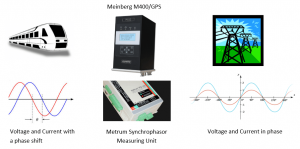By Andreja Jarc.
The production and demand of electrical power must be the same at all times for stability and optimal operation of railway power grids. If there is too much power it will dissipate as heat or cause an over load at a transform station with a damaging result. On the other hand, not having enough power in grids can result in a train not getting enough power to move with the right speed or might even cause power breaks.
Modern railway engines consume energy when they start, but when they slow down or break the engine rotates backwards and therefore produces power back to the grid. Trains are moving around all the time so this is happening anywhere in the power grid network.
Figure 1: Electrical power balancing in railway grids. Source: Metrum, Sweden.
A number of devices are built in electrical grids which monitor the power quality and energy flows with the purpose of optimizing power consumption and reducing losses. Accurate synchrophasor monitoring and time stamped measurements are essential to ensure optimal operation of converter stations at all times. This way power flows can be precisely analyzed and the converters can be fine-tuned to correct their static phase shifting properties and the dynamic behavior.
In Sweden, the railway operates with low-frequency single-phase alternating current at 16 2/3 Hz which is one third of the normal power grid frequency of 50 Hz. Because of this, the power needs to be frequency shifted at converter stations spread all over the country.
The Meinberg M400/GPS provides accurate time stamps in converter stations, equipped by Metrum units, which calculate the phasor information for both 50 Hz and 16 2/3 Hz. The phasors are then used to analyze power flows in the system and provide a basis for the adjustment of frequency converters to optimize operation in order to reduce power losses.
Figure 2: Metrum synchrophasor measuring unit (PQ 140) complemented with Meinberg M400/GPS sync and timestamp unit used to sync voltage and current for optimal power balance in converter stations.
This technology can be used in many other power grid applications to save the energy and take away correlation or overload energy.
Meinberg would like to acknowledge Metrum for their contribution in this project and we are looking forward to new opportunities for a joint cooperation.
For more information about Meinberg Synchronization Solutions in power networks and smart grids visit our website: www.meinbergglobal.com or contact me to: andreja.jarc(at)meinberg.de


Saving electrical powers in electrical grid is one of the best way to save environment and save money. I always love to read your blog.